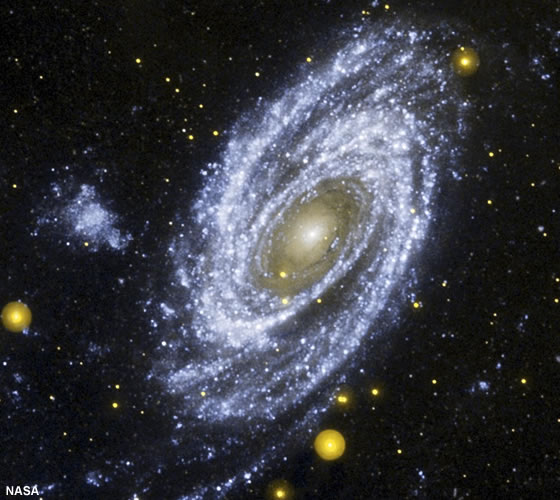So:
- If inflation happened, things should have been pushed outside our horizon. (Think light-cone.)
- As said before, the quantum fields during inflation would create perturbations on all scales, including the scales being pushed out of our horizon.
- After inflation stops, our horizon has a chance to "expand again" allowing those perturbations that got pushed outside our horizon to fall back in.
- These perturbations allow for gravitational collapse to form things like galaxies out of the matter contained inside the perturbation.
- Perturbations on the order of 1 Mpc (3 million light years) contain, given the density of matter in the universe, ~10^12 solar masses of matter and fell inside our horizon long enough ago to allow this matter to collapse into galaxies.
- We see galaxies with 10^12 stars in them. Check!
- Here's the kicker: Perturbations on the order of 10 Mpc fell into our horizon recent enough that there has not been enough time to have galaxies form from all the matter contained withen them.
- We see no galaxies with 10^15 stars in them. Double check!
- They have, however, re-entered long enough ago that we can measure stochastic properties of such perturbations confirming their existence. Triple check.
This doesn't prove anythings as much as to say: what you should expect coming from inflationary cosmology is exactly what you see.
(Repeating myself) Perturbations should have been created and, since inflation happened, pushed out of our light cone. Those who fell in long enough ago should have formed things like galaxies with as much matter as is contained in such perturbations. Those that are so large that they only fell into our horizon recently should not yet have formed galaxies containing all the matter they posses, meaning we should not see galaxies with their order of mass. We don't. We should however be able to discern they exist by their statistical properties. They do and it is yet another subtle triumph for cosmology.
Think about it:
If the universe has really been around forever without anything like some inflationary phase: Why hasn't gravity pulled all the galaxies we see into bigger mega-galaxies by now? Like always, inflationary cosmology provides the answer.
Think about it:
If the universe has really been around forever without anything like some inflationary phase: Why hasn't gravity pulled all the galaxies we see into bigger mega-galaxies by now? Like always, inflationary cosmology provides the answer.

Well and clearly said!
ReplyDeleteThanks Ben.
ReplyDeleteThis line of thought, which I think is simply a statement that gravity waves travel at the speed of sound, does seem to validate our models.
ReplyDeleteFurther, this effect could also be seen in galaxy surveys, like BOSS, in large scale structure. Are there any good review papers that outline what we expect to (not) see?
The Astronomist,
ReplyDeleteMy favorite text on this issue is "The Primordial Density Perturbation" by Lyth and Liddle. I believe Dodelson's book has related material.
A free paper for the general theory of perturbations exiting and reentering the horizon in a review article I recommend "TASI Lectures on Inflation" by Baumann: http://arxiv.org/abs/0907.5424
I will post others as the come to me. Unfortunately, for the observational side of things I have mostly learned from textbooks. (The Baumann lectures are the best review article for theory in my opinion.)